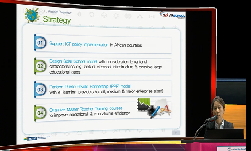Records of gender equity in higher education administration have shown that women have been the second choice in the selection as higher education administrators. For the reason that many women think that they cannot be hired as much as their male co...
http://chineseinput.net/에서 pinyin(병음)방식으로 중국어를 변환할 수 있습니다.
변환된 중국어를 복사하여 사용하시면 됩니다.
- 中文 을 입력하시려면 zhongwen을 입력하시고 space를누르시면됩니다.
- 北京 을 입력하시려면 beijing을 입력하시고 space를 누르시면 됩니다.
A study of selected women administrators and their perceptions of the challenges encountered in achieving high level positions in higher education administration.
한글로보기https://www.riss.kr/link?id=T10554382
- 저자
-
발행사항
[S.l.]: Michigan State University 2001
-
학위수여대학
Michigan State University
-
수여연도
2001
-
작성언어
영어
- 주제어
-
학위
Ph.D.
-
페이지수
293 p.
-
지도교수/심사위원
Adviser: Carroll Wamhoff.
-
0
상세조회 -
0
다운로드
소속기관이 구독 중이 아닌 경우 오후 4시부터 익일 오전 9시까지 원문보기가 가능합니다.
부가정보
다국어 초록 (Multilingual Abstract)
The study investigated the progress that women have made in attaining positions in higher education administration in the early 1980s. The researcher intended to utilize information obtained to provide guidance and perspective to women who aspire to top level administrative positions in higher education.
This study used a qualitative interview method was used to gain an in-depth understanding of purposively selected participants from their perspective. A list of fourteen research questions were administered to purposively selected female administrators in three categories of administration, from three higher institutions of learning in Michigan. The qualitative data analytical method consisted of words and statements, which expressed qualities rather than quantities, was used to describe and summarize the data. This constant qualitative data analysis relied on the findings from the fourteen research questions to determine the most critical consistencies and inconsistencies with the literature review.
The findings on the perceptions of the female administrators from research questions two through fourteen were consistent with the literature review. It is not possible to draw conclusions that the findings from research question one is neither consistent nor inconsistent because there is no review of literature on demographic information. It was observed from the findings that the female administrators interviewed were aware that females have made gains in appointments to higher education administrative positions. They still believe, however, that balance, proportionately, is needed with male counterparts. The study participants were in agreement that there are serious societal sex-stereotypical hindrances that need to be completely removed. Such action would permit females to more visibly recognized and on equal basis with their male counterparts.
Records of gender equity in higher education administration have shown that women have been the second choice in the selection as higher education administrators. For the reason that many women think that they cannot be hired as much as their male counterparts are hired in higher education administrative positions, some of them took it for granted that they are the endangered species in the administration of higher education. The purpose of this study was to identify the enhancing and challenging factors influencing the achievement of women who reached top levels of administration in selected Michigan Universities; and to determine whether these factors are different from those perceived by other researchers who are concerned with the issue of inequity in higher education administrative positions.
The study investigated the progress that women have made in attaining positions in higher education administration in the early 1980s. The researcher intended to utilize information obtained to provide guidance and perspective to women who aspire to top level administrative positions in higher education.
This study used a qualitative interview method was used to gain an in-depth understanding of purposively selected participants from their perspective. A list of fourteen research questions were administered to purposively selected female administrators in three categories of administration, from three higher institutions of learning in Michigan. The qualitative data analytical method consisted of words and statements, which expressed qualities rather than quantities, was used to describe and summarize the data. This constant qualitative data analysis relied on the findings from the fourteen research questions to determine the most critical consistencies and inconsistencies with the literature review.
The findings on the perceptions of the female administrators from research questions two through fourteen were consistent with the literature review. It is not possible to draw conclusions that the findings from research question one is neither consistent nor inconsistent because there is no review of literature on demographic information. It was observed from the findings that the female administrators interviewed were aware that females have made gains in appointments to higher education administrative positions. They still believe, however, that balance, proportionately, is needed with male counterparts. The study participants were in agreement that there are serious societal sex-stereotypical hindrances that need to be completely removed. Such action would permit females to more visibly recognized and on equal basis with their male counterparts.
분석정보
연관 공개강의(KOCW)
-

Education Policy at the Party Conferences
Teachers TV Teachers TV -

2014 이러닝 국제 콘퍼런스 : What is the Lessons from Education Support Project~
한국교육정보진흥협회 Boseon, Kim -

Early Sex Education: The Debate
Teachers TV Teachers TV -

Alcohol Education: Here's What We Want
Teachers TV Teachers TV -

Personal Finance Education: The Money Quiz
Teachers TV Teachers TV






